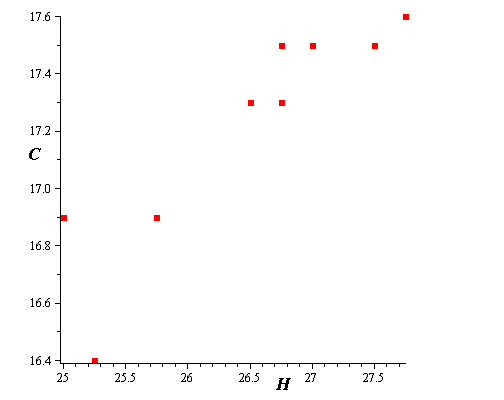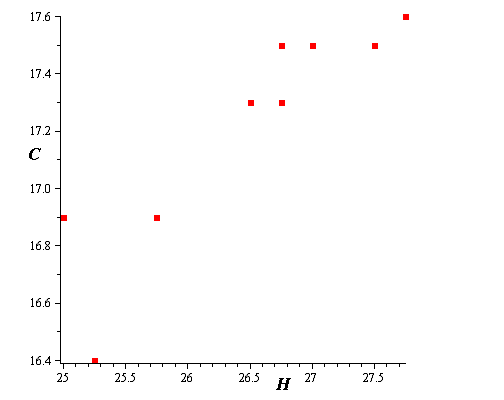
Concept explainers
a.
Use a graphing utility to draw
a.
Answer to Problem 20AYU

Explanation of Solution
Given information:
A paediatrician wanted to find a linear model that relates a child’s height,
Use a graphing utility to draw scatter diagram.
Calculation:
The scatter diagram is as shown,

Hence, The scatter diagram is as plotted.
b.
Express the model using function notation.
b.
Answer to Problem 20AYU
Explanation of Solution
Given information:
A paediatrician wanted to find a linear model that relates a child’s height,
Use a graphing utility to find the line of best fit that models the relation between height and head circumference. Express the model using function notation.
Calculation:
Express the model using function notation.
We know the linear function,
Hence, the line in function notation is,
c.
Interpret the slope.
c.
Answer to Problem 20AYU
Head circumference is increased by smaller amount as compared to the height of the child.
Explanation of Solution
Given information:
A paediatrician wanted to find a linear model that relates a child’s height,
Interpret the slope.
Calculation:
The slope of line
As the slope of the line is less than one so head circumference is increased by smaller amount as compared to the height of the child.
Hence, head circumference is increased by smaller amount as compared to the height of the child.
d.
Predict the head circumference of childe that is
d.
Answer to Problem 20AYU
Explanation of Solution
Given information:
A paediatrician wanted to find a linear model that relates a child’s height,
Predict the head circumference of childe that is
Calculation:
The head circumference of childe that is
Put
Hence, the head circumference of childe that is
e.
What is height of child whose head circumference is
e.
Answer to Problem 20AYU
Explanation of Solution
Given information:
A paediatrician wanted to find a linear model that relates a child’s height,
What is height of child whose head circumference is
Calculation:
Put
Hence, the height of child is,
Chapter 3 Solutions
Precalculus Enhanced with Graphing Utilities
Additional Math Textbook Solutions
University Calculus: Early Transcendentals (4th Edition)
Elementary Statistics: Picturing the World (7th Edition)
A Problem Solving Approach To Mathematics For Elementary School Teachers (13th Edition)
College Algebra (7th Edition)
- f(x) = = x - 3 x²-9 f(x) = {x + 1 x > 3 4 x < 3 -10 5 10 5 5. 10 5- 07. 10 -10 -5 0 10 5 -101 :: The function has a “step" or "jump" discontinuity at x = 3 where f(3) = 7. :: The function has a value of f (3), a limit as x approaches 3, but is not continuous at x = 3. :: The function has a limit as x approaches 3, but the function is not defined and is not continuous at x = 3. :: The function has a removable discontinuity at x=3 and an infinite discontinuity at x= -3.arrow_forwardCalculus lll May I please have the solutions for the following examples? Thank youarrow_forwardCalculus lll May I please have the solutions for the following exercises that are blank? Thank youarrow_forward
- The graph of 2(x² + y²)² = 25 (x²-y²), shown in the figure, is a lemniscate of Bernoulli. Find the equation of the tangent line at the point (3,1). -10 Write the expression for the slope in terms of x and y. slope = 4x³ + 4xy2-25x 2 3 4x²y + 4y³ + 25y Write the equation for the line tangent to the point (3,1). LV Q +arrow_forwardFind the equation of the tangent line at the given value of x on the curve. 2y3+xy-y= 250x4; x=1 y=arrow_forwardFind the equation of the tangent line at the given point on the curve. 3y² -√x=44, (16,4) y=] ...arrow_forward
- For a certain product, cost C and revenue R are given as follows, where x is the number of units sold in hundreds. Cost: C² = x² +92√x+56 Revenue: 898(x-6)² + 24R² = 16,224 dC a. Find the marginal cost at x = 6. dx The marginal cost is estimated to be $ ☐ . (Do not round until the final answer. Then round to the nearest hundredth as needed.)arrow_forwardThe graph of 3 (x² + y²)² = 100 (x² - y²), shown in the figure, is a lemniscate of Bernoulli. Find the equation of the tangent line at the point (4,2). АУ -10 10 Write the expression for the slope in terms of x and y. slope =arrow_forwardUse a geometric series to represent each of the given functions as a power series about x=0, and find their intervals of convergence. a. f(x)=5/(3-x) b. g(x)= 3/(x-2)arrow_forward
- An object of mass 4 kg is given an initial downward velocity of 60 m/sec and then allowed to fall under the influence of gravity. Assume that the force in newtons due to air resistance is - 8v, where v is the velocity of the object in m/sec. Determine the equation of motion of the object. If the object is initially 500 m above the ground, determine when the object will strike the ground. Assume that the acceleration due to gravity is 9.81 m/sec² and let x(t) represent the distance the object has fallen in t seconds. Determine the equation of motion of the object. x(t) = (Use integers or decimals for any numbers in the expression. Round to two decimal places as needed.)arrow_forwardEarly Monday morning, the temperature in the lecture hall has fallen to 40°F, the same as the temperature outside. At 7:00 A.M., the janitor turns on the furnace with the thermostat set at 72°F. The time constant for the building is = 3 hr and that for the building along with its heating system is 1 K A.M.? When will the temperature inside the hall reach 71°F? 1 = 1 hr. Assuming that the outside temperature remains constant, what will be the temperature inside the lecture hall at 8:30 2 At 8:30 A.M., the temperature inside the lecture hall will be about (Round to the nearest tenth as needed.) 1°F.arrow_forwardFind the maximum volume of a rectangular box whose surface area is 1500 cm² and whose total edge length is 200 cm. cm³arrow_forward
 Calculus: Early TranscendentalsCalculusISBN:9781285741550Author:James StewartPublisher:Cengage Learning
Calculus: Early TranscendentalsCalculusISBN:9781285741550Author:James StewartPublisher:Cengage Learning Thomas' Calculus (14th Edition)CalculusISBN:9780134438986Author:Joel R. Hass, Christopher E. Heil, Maurice D. WeirPublisher:PEARSON
Thomas' Calculus (14th Edition)CalculusISBN:9780134438986Author:Joel R. Hass, Christopher E. Heil, Maurice D. WeirPublisher:PEARSON Calculus: Early Transcendentals (3rd Edition)CalculusISBN:9780134763644Author:William L. Briggs, Lyle Cochran, Bernard Gillett, Eric SchulzPublisher:PEARSON
Calculus: Early Transcendentals (3rd Edition)CalculusISBN:9780134763644Author:William L. Briggs, Lyle Cochran, Bernard Gillett, Eric SchulzPublisher:PEARSON Calculus: Early TranscendentalsCalculusISBN:9781319050740Author:Jon Rogawski, Colin Adams, Robert FranzosaPublisher:W. H. Freeman
Calculus: Early TranscendentalsCalculusISBN:9781319050740Author:Jon Rogawski, Colin Adams, Robert FranzosaPublisher:W. H. Freeman
 Calculus: Early Transcendental FunctionsCalculusISBN:9781337552516Author:Ron Larson, Bruce H. EdwardsPublisher:Cengage Learning
Calculus: Early Transcendental FunctionsCalculusISBN:9781337552516Author:Ron Larson, Bruce H. EdwardsPublisher:Cengage Learning





